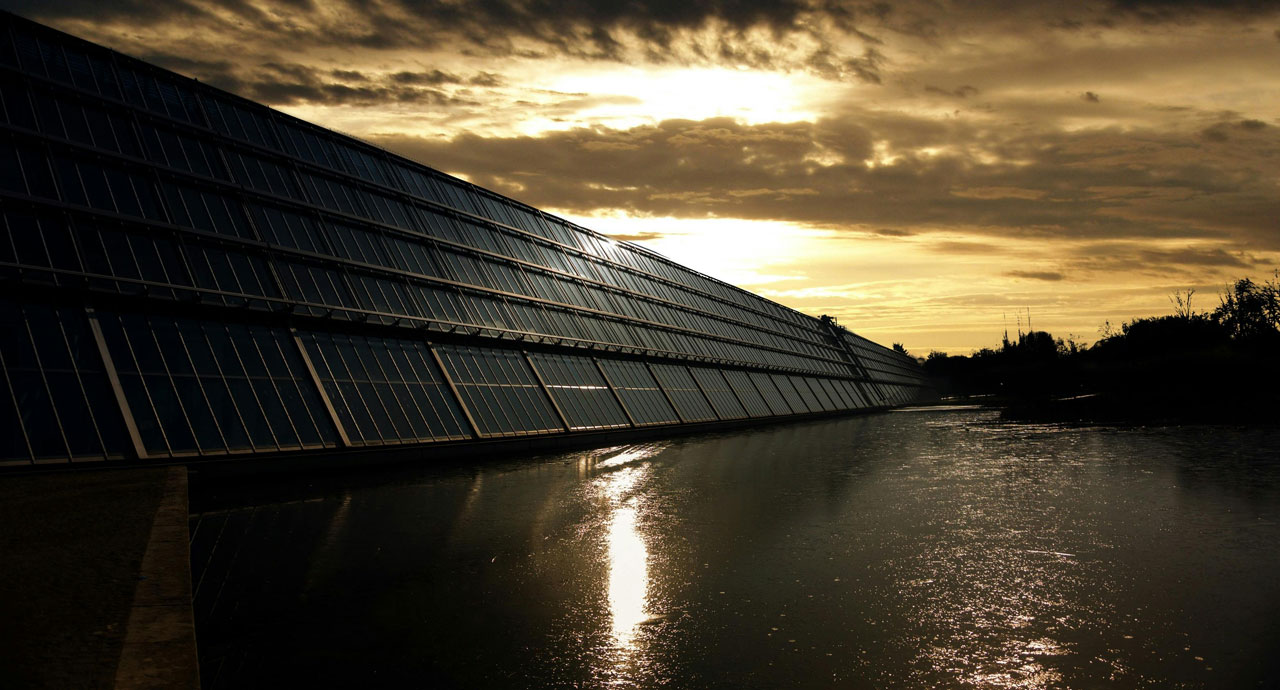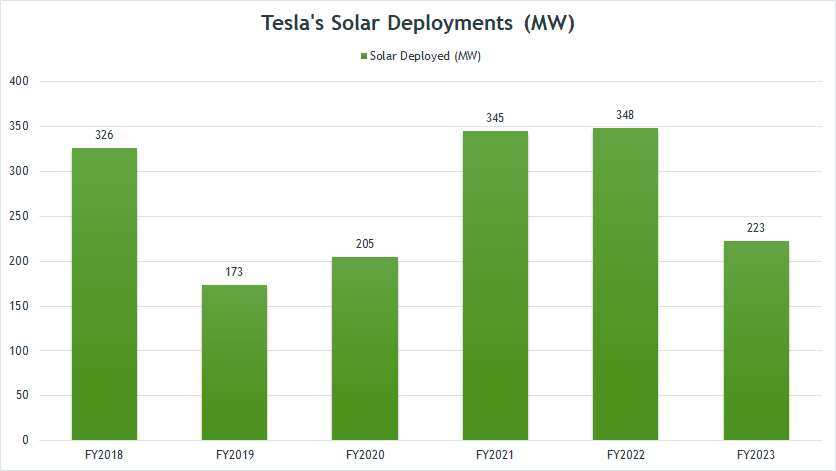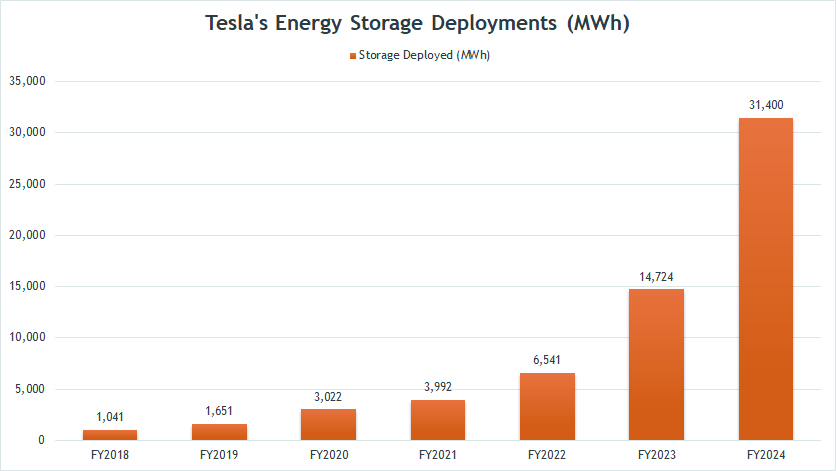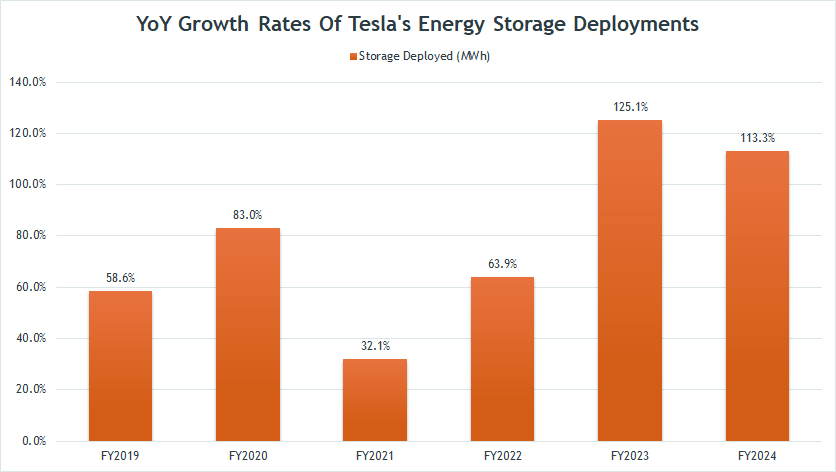
Solar power. Pexels Image.
This article presents Tesla’s energy segment solar and storage deployments.
Let’s take a look! You may find related statistic of Tesla on these pages:
- Tesla energy revenue and gross margin,
- Tesla operating expenses breakdown analysis, and
- Tesla solar vs automotive.
Please use the table of contents to navigate this page.
Table Of Contents
Definitions And Overview
O2. Why isn’t Tesla’s solar business taking off?
Solar And Storage Deployments
A1. Solar Deployments
A2. Energy Storage Deployments
Growth Rates
B1. YoY Growth Rates Of Solar Deployments
B2. YoY Growth Rates Of Energy Storage Deployments
Conclusion And Reference
S1. Conclusion
S2. References and Credits
S3. Disclosure
Definitions
To help readers understand the content better, the following terms and glossaries have been provided.
Enery Storage Deployment: Energy storage deployment refers to the process of installing and utilizing energy storage systems to store excess energy generated from renewable sources, such as solar or wind power, for later use.
These storage systems can provide power during peak demand when energy costs are higher or during power outages.
Energy storage deployment is an important aspect of transitioning to a more sustainable and reliable energy system, as it allows for better integration of renewable energy sources and reduces reliance on fossil fuels.
Solar Deployment: Solar deployment refers to installing and utilizing solar energy systems, such as solar panels, to generate electricity from sunlight.
This involves the installation of solar panels on rooftops, fields, or other suitable surfaces to capture sunlight and convert it into usable energy.
Solar deployment is an important aspect of transitioning to a more sustainable and renewable energy system, as it allows for the generation of clean energy while reducing reliance on fossil fuels.
Megawatt (MW): A megawatt (MW) is a power unit equal to one million watts. It is commonly used to measure large power plants’ output power or industrial facilities’ power consumption.
One megawatt equals 1,000 kilowatts (kW) or 1,000,000 watts (W). The capacity for 1 megawatt (MW) of power depends on the type of power generation technology used.
For example, a 1 MW wind turbine can generate enough electricity to power around 300 homes, while a 1 MW natural gas turbine can power around 1,000 homes.
Megawatt Hour (MWh): A megawatt-hour (MWh) is a unit of energy equivalent to one million watt-hours.
It is commonly used to measure the amount of energy consumed or produced over a certain period by large power plants or industrial facilities. For example, if a power plant generates 1 megawatt of power for one hour, it would produce 1 MWh of energy.
The capacity of 1 megawatt-hour (MWh) of energy does not directly correspond to the number of homes it can power, as the amount of energy a home consumes can vary widely depending on factors such as the size of the home, the number of occupants, and the appliances and devices used.
However, as a rough estimate, one MWh of energy could potentially power around 400 to 900 homes for an hour, depending on the average energy consumption of those homes.
It’s important to note that this is just an estimate, and the actual number of homes that 1 MWh of energy can power can vary widely depending on many factors.
Why isn’t Tesla’s solar business taking off?
Tesla’s solar business has faced several challenges recently. Here are a few key reasons:
- High Interest Rates: Sustained high interest rates have made solar installations more expensive, which has slowed down demand.
- End of Net Metering: In places like California, the end of net metering policies has reduced the financial incentives for homeowners to install solar panels.
- Strategic Shift: Tesla has shifted its focus from being an installer to more of a supplier, which has led to layoffs and cancellations of scheduled installations.
- Market Competition: The solar market is highly competitive, with many other companies offering similar products and services, which can impact Tesla’s market share.
- Economic Factors: Broader economic factors, such as supply chain disruptions and inflation, have also played a role in the decline.
Despite these challenges, Tesla’s energy storage business, including products like the Powerwall and Megapack, has been booming. This has helped offset some of the losses from the solar business.
Solar Deployments
tesla-solar-deployments
(click image to expand)
You may find the definitions of solar deployments and Megawatt (MW) here: solar deployment and Megawatt (MW).
In fiscal year 2023, Tesla deployed a total capacity of 223 MW for its solar equipment, reflecting a 36% decrease compared to the 348 MW deployed in fiscal year 2022.
Tesla highlighted that the decrease in solar deployment is primarily due to the high-interest rate environment that has caused an industry-wide postponement of solar purchases.
Besides, the significant drop has raised questions about the company’s solar strategy and market conditions.
Starting from fiscal year 2024, Tesla has opted not to disclose specific solar deployment figures, leaving analysts and investors to speculate on the performance of its solar division.
This shift in transparency could be part of Tesla’s evolving business strategy or a response to competitive pressures in the renewable energy market.
Energy Storage Deployments
tesla-energy-storage-deployments
(click image to expand)
You may find the definitions of energy storage deployments and Megawatt Hour (MWh) here: energy storage deployment and Megawatt Hour (MWh).
In contrast to its solar deployments, Tesla’s energy storage deployments have remained robust, even during the peak of the COVID-19 crisis in fiscal year 2020.
Since fiscal year 2018, Tesla’s energy storage deployments have surged by over 3000%, reaching an all-time high of 31,400 MWh in fiscal year 2024, representing a 113% year-on-year increase.
This tremendous growth highlights Tesla’s ability to scale its energy storage solutions effectively. The continued ramp-up of Tesla’s Megapack factory (Megafactory) in Lathrop, CA, has contributed to the incredible growth in the company’s energy storage business.
The Megafactory plays a crucial role in meeting the growing demand for energy storage systems, enabling Tesla to produce large quantities of Megapacks efficiently.
Tesla’s energy storage products, such as the Powerwall for residential use and the Megapack for utility-scale projects, have gained significant traction in the market.
These products offer reliable and scalable solutions for energy storage, helping to stabilize the grid and support the integration of renewable energy sources.
Furthermore, Tesla’s energy storage deployments are crucial for achieving the company’s mission of accelerating the world’s transition to sustainable energy.
By providing efficient energy storage solutions, Tesla is enabling greater adoption of renewable energy and reducing reliance on fossil fuels.
It appears that Tesla is excelling in the energy storage sector, positioning itself as a leader in this rapidly growing market.
YoY Growth Rates Of Solar Deployments
tesla-solar-deployments-yoy-growth-rates
(click image to expand)
You may find the definitions of solar deployments and Megawatt (MW) here: solar deployment and Megawatt (MW).
From fiscal year 2021 to 2023, Tesla’s solar deployments grew at an average annual rate of just 11%. However, since fiscal year 2022, the growth of Tesla’s solar installations has been slowing down significantly.
The year-over-year growth rate fell to a mere 1% in fiscal year 2022, and by fiscal year 2023, the company recorded a decline of 36%.
This deceleration in solar growth highlights some underlying challenges Tesla’s solar division is facing. High interest rates have increased the cost of solar installations, discouraging potential customers.
Changes in policies, such as the end of net metering in certain regions, have also reduced financial incentives for homeowners to adopt solar solutions.
Moreover, Tesla’s strategic shift from being an installer to focusing more on supplying solar products has contributed to the slowdown. Market competition remains fierce, with many other companies vying for a share in the renewable energy sector.
Looking ahead, Tesla’s approach to reviving its solar business and adapting to market conditions will be crucial in determining its future performance in this sector.
YoY Growth Rates Of Energy Storage Deployments
tesla-energy-storage-deployments-yoy-growth-rates
(click image to expand)
You may find the definitions of energy storage deployments and Megawatt Hour (MWh) here: energy storage deployment and Megawatt Hour (MWh).
Contrary to the sluggish growth in solar deployments, Tesla’s energy storage deployments have experienced remarkable growth.
Over the past three years, from fiscal year 2022 to 2024, Tesla’s energy storage deployments have increased by over 100% annually on average.
In fiscal year 2024, Tesla’s energy storage deployments soared by 113%, marking a record growth rate not seen in the past six years.
This impressive growth can be attributed to the increasing demand for Tesla’s energy storage products, such as the Powerwall and Megapack, which offer reliable and scalable solutions for both residential and utility-scale energy storage.
The continued ramp-up of the Megapack factory (Megafactory) in Lathrop, CA, has played a pivotal role in meeting the growing demand and achieving these record deployment figures.
The factory’s increased production capacity has enabled Tesla to address larger-scale projects and cater to a broader customer base.
As the world transitions towards renewable energy sources, Tesla’s energy storage solutions are becoming increasingly vital for grid stability and the integration of intermittent energy sources like solar and wind.
This consistent growth trajectory positions Tesla as a leader in the energy storage market, reinforcing its mission to accelerate the world’s transition to sustainable energy.
Conclusion
While Tesla’s solar deployments have faced recent setbacks, the company’s energy storage deployments have shown exceptional growth and promise.
The divergence in performance between these two segments underscores the challenges and opportunities Tesla faces in the renewable energy sector.
The company’s ongoing efforts to innovate and expand its energy storage solutions highlight its commitment to accelerating the world’s transition to sustainable energy.
References and Credits
1. All financial figures presented were obtained and referenced from Tesla’s annual reports published on the company’s investor relations page: Tesla Update Letters and Presentations.
2. Pexels Images.
Disclosure
We may utilize the assistance of artificial intelligence (AI) tools to produce some of the text in this article. However, the data is directly obtained from original sources and meticulously cross-checked by our editors multiple times to ensure its accuracy and reliability.
If you find the information in this article helpful, please consider sharing it on social media. Additionally, providing a link back to this article from any website can help us create more content like this in the future.
Thank you for your support and engagement! Your involvement helps us continue to provide high-quality, reliable content.




